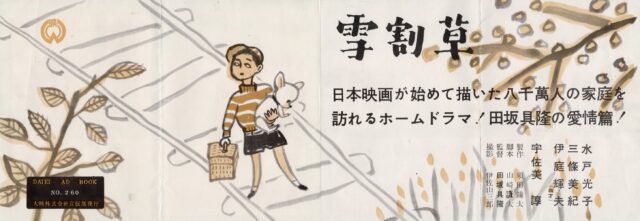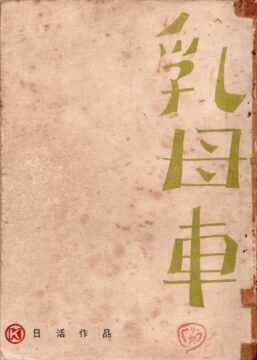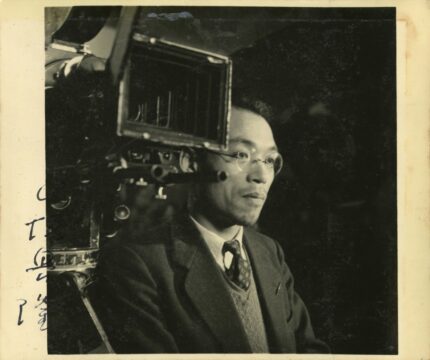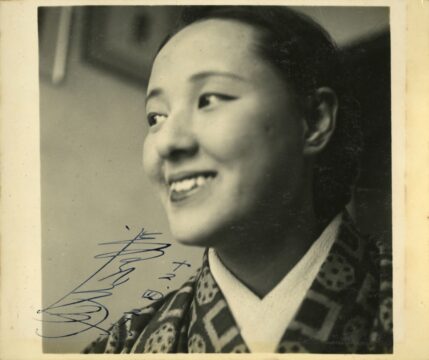
When looking at the rich history of Japanese cinema, it is impossible to forget the name of the famous director Tasaka Tomotaka (1902-1974). Tasaka made his debut in 1926 with The Pumpkin Riots, and soon established a style full of humanism with literary works such as The True Path (1937) and The Roadside Stone (1938), and together with Uchida Tomu, he built the heyday of Nikkatsu Tamagawa Studios. Furthermore, from The Five Scouts (1938) onwards, he made a name for himself as a creator of war films full of realism and humanity.
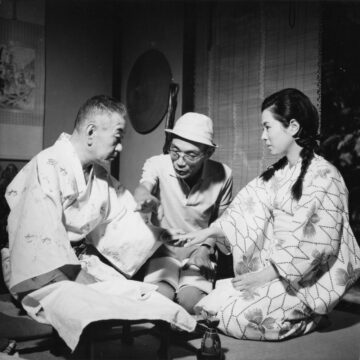
Snapshots from "Lake no Koto" (1966) (from left: Nakamura Ganjiro II, Director Tasaka, and Sakuma Yoshiko) Courtesy of the Gogyukai Association
In August 1945, Tasaki was exposed to the atomic bomb in Hiroshima and was forced to fight with illness for several years. However, after recovering, he devoted himself to nurturing stars such as Ishihara Yujiro, Nakamura Kinnosuke, and Sakuma Yoshiko at various film studios, and left behind many masterpieces, including "The Maid Girl" (1955), "The Sunny Slope" (1958), "Little Kobe" (1962), and "Gobancho Yugirirou" (1963).
Despite boasting such a brilliant body of work, Tasaka has not been given the opportunity to be reevaluated for a long time. However, his style of work, which has always been close to the small and the weak, is full of encouragement for people who strive to live sincerely, and it is sure to shine brightly in this era in which we are plagued by successive disasters and social intolerance is increasing. This year marks half a century since his death, and in conjunction with the publication of a book about Tasaka, the museum will hold its first retrospective exhibition, displaying valuable materials provided by those involved, as well as a special screening of his directorial works. Through Tasaka, who sincerely believed in the "goodness" of human beings, we will provide an opportunity to reexamine film and the human life that lies beyond it.
Attractions
- The first large-scale retrospective to be held half a century after his death
Although he is a master director who has created many works that have left their mark on film history and who has been held in the deep respect of such stars as Yujiro Ishihara and Yoshiko Sakuma, Tomotaka Tasaka has long missed the opportunity to be reevaluated. This exhibition, held half a century after his death, is the first large-scale retrospective to highlight Tasaka's enormous achievements.
- Valuable materials related to Tomotaka Tasaka gathered in one place from various sources
Tasaka Tomotaka has always valued his staff and actors. This time, about 170 valuable exhibits from various sources will be gathered together in one place, including the scripts he used on set and materials formerly owned by actor and film director Isamu Kosugi, who was a family friend of his.
- Large-scale screening events will also be held during the event.
Large-scale special screenings of the same title will be held from October 8th (Tue) to 20th (Sun) and from November 5th (Tue) to 24th (Sun).
The program of 40 works, including all of Tasaka's existing works as well as works by people connected to Tasaka, such as Hisako Takihana, Tomu Uchida, Seiichi Ina, and Isamu Kosugi, is overwhelming.
- Also check out the new books related to the exhibition that will deepen your understanding of the exhibition
During the exhibition, "Guryu-san: Film Director Tasaka Tomotaka" (edited by Sasanuma Mariko, Sasaki Junaki, and Sato Chihiro, published by Kokusho Kankokai), a compilation of Tasaka's statements and writings as well as testimonies from those involved, is scheduled to be published. Please take a look at the related books that will deepen your understanding of the exhibition.
・Exhibition structure
Chapter 1
Eyes on Small Things: Children from the Meiji Period to the Early Showa Period
Tasaka Tomotaka has always depicted "small things" in his own work. His subjects are never limited to boys and girls, but he focuses his attention on the small things that tend to be overlooked on the periphery of the screen, such as accused people living on the fringes of society and wild flowers. In this chapter, we trace the lineage of "small things" depicted in works such as "The Path of Truth" (1937) and "A Stone by the Wayside" (1938), which marked turning points for Tasaka Tomotaka in his younger days when he was active at Nikkatsu Tamagawa Studios, as well as "Mother and Child" (1942), the film of which is now lost.
Chapter 2
War and humanity
With the success of "Five Scouts" (1938) and "Earth and Soldiers" (1939), Tasaka Tomotaka pioneered a new field of war films that was full of realism and humanity, and continued to produce works energetically even in difficult times. However, his life was greatly tossed about by the war, as he experienced the devastation of the atomic bomb in his hometown of Hiroshima and was on the brink of death due to after-effects. After the war, he was one of the first to conceive a film adaptation of "The Burmese Harp" in 1950, but gave up on the idea. However, he continued to honestly confront war and peace, such as by producing "Nagasaki no Uta wa Wasureji" (1952), set in the atomic bombed city of Nagasaki.

"Earth and Soldiers" (1939) "Local Stills Exhibition" poster, National Film Archive of Japan (Kosugi Isamu Collection)
Chapter 3
Eyes on Small Things: Children after the War
After experiencing the atomic bombing of Hiroshima and battling illness, Tasaka Tomotaka began his postwar directorial career with "Doburoku no Tatsu" in 1949, and even more so than before the war, he continued to focus on "small things." The underlying idea is that children are the biggest victims of the ravages of war. This chapter looks at the postwar children that Tasaka portrayed through materials, costumes, and props from works such as "Snowdrops" (1951), which features a young boy as the protagonist, "The Maid" (1955), which marked his full-fledged comeback after another bout with illness, and "Yukan Kozo" (1953), which was left unfinished.
Chapter 4
Postwar Rebirth in Literary Films
After the atomic bombing, Tasaka Tomotaka was struggling with illness, and while he was in bed he read Eiji Yoshikawa's novel Shinran, which made a deep impression on him. A dozen years later, in 1960, he began adapting it for the screen, completing a profound two-part series. In addition to this, Tasaka Tomotaka made a succession of films based on bestselling novels by popular authors such as Yojiro Ishizaka, Shugoro Yamamoto, and Tsutomu Mizukami, which were highly acclaimed. In these works, he actively employed young stars such as Yujiro Ishihara, Kinnosuke Nakamura, Izumi Ashigawa, and Yoshiko Sakuma, as well as up-and-coming screenwriter Naoyuki Suzuki, and these works marked new territory for them as well.
Chapter Five
People and Lifestyle
Many film people gathered around Tasaka Tomotaka, who had a long career in the film industry. Not only did he have a lifelong partner and regular actor in his films, Takihana Hisako, directors of the same generation such as Uchida Tomu and Ina Seiichi, who worked in the film industry with him, but also Kosugi Isamu, an actor and film director with whom he had a long friendship both in public and private, and Ina Seiichi's wife, Ina Moto, who worked as a hairstylist. As in his films, in which he continued to focus on "small things," Tasaka also collected folk crafts and regional toys in his private life, sometimes using them as props in his films. We will get closer to the character of Tasaka Tomotaka through materials related to him and film people with whom he had connections.
Related screening projects
A screening project will be held in conjunction with this exhibition.
"50 years after the death of film director Tomotaka Tasaka"
Dates: October 8th (Tuesday) – 20th (Sunday), November 5th (Tuesday) – 24th (Sunday), 2024
Venue: National Film Archive Nagase Memorial Hall OZU (2nd floor)
・Talk event
We will hold gallery talks with invited guests and explanations of the exhibits by museum researchers.
*Details of each event will be announced on the website at a later date.
War and Children: Two Phantom Projects by Tomotaka Tasaka Date: Saturday, September 21, 2024
Lecturer: Chihiro Sato (Film researcher)
Location: Exhibition Lobby (7th floor)
The program looks back on Tasaka's work, focusing on the postwar period of struggle when he was trying to make a comeback, including "The Burmese Harp," which he was supposed to direct, and "The Evening Paper Boy," whose filming was halted.
Highlights of the project and explanation of exhibits <br /> Date: Saturday, October 19, 2024
Lecturers: Mariko Sasanuma (Representative of the Gogyu Association), Yoshiaki Sazaki (Visiting Researcher at the Embassy of Japan),
Location: Exhibition room (7th floor)
To mark the 50th anniversary of Tasaki's death on October 17th, we will explain the highlights of the exhibition and its main exhibits.
・Introduction of audio material "Kishimatsu Takeshi talks about Tasaka Tomotaka"
Date: Saturday, November 16, 2024
Commentary by: Yoshiaki Sasaki (Visiting Researcher at the Museum)
Location: Exhibition Lobby (7th floor)
This rare audio recording will be released of film critic Kishi Matsuo talking about Tasaki's career and memories at the screening of "Roadside Stone" at the former Film Center on September 25, 1975.
・Related books New releases
"Gryu-san: Film Director Tomotaka Tasaka"
Edited by Mariko Sasanuma, Yoshiaki Sasaki, and Chihiro Sato Published by Kokusho Kankokai Scheduled for publication: October 2024
ISBN:978-4-336-07654-0
A5 size, hardback, approx. 620 pages Estimated price: 8,000 yen + tax
Event summary
Project title : 50 years after the death of film director Tomotaka Tasaka
Organized by : National Film Archive of Japan
Cooperation : Gogyukai
Date : September 7th [Sat] – November 24th [Sun], 2024
Closed : Mondays
Opening hours : 11:00am – 6:30pm (entry until 6:00pm)
*Opening hours will be extended until 8pm on Fridays, September 27th and October 25th. (Entry until 7:30pm)
Venue: National Film Archive Exhibition Room (7th floor)
Access : From Kyobashi Station on the Tokyo Metro Ginza Line, walk 1 minute from Exit 1 towards Showa Dori. From Takaracho Station on the Toei Subway Asakusa Line, walk 1 minute from Exit A4 towards Chuo Dori. From Ginza-itchome Station on the Tokyo Metro Yurakucho Line, walk 5 minutes from Exit 7.
Get off at JR Tokyo Station, 10 minutes walk from Yaesu South Exit
Fee
Adults 250 yen (200 yen) / University students 130 yen (60 yen) / Free for those aged 65 or older, high school students and younger, those under 18, those with a disability certificate (up to one accompanying person in principle), and National Film Archive of Japan Campus Members *Price includes admission to the permanent exhibition "History of Japanese Film."
*Prices in parentheses are for groups of 20 or more.
*Students, people aged 65 or over, people with disabilities, and campus members must show proof of identity upon entry.
*If you present a ticket for a screening hosted by the National Film Archive of Japan (online ticket "purchase confirmation email" or QR code printout), the group rate will be applied only once.
* Free viewing on Culture Day, Sunday, November 3, 2024 (national holiday).
Inquiries: 050-5541-8600 (Hello Dial)
HP: https://www.nfaj.go.jp/exhibition/film-director-tomotaka-tasaka2024/
[Agency for Cultural Affairs] Press Release
<Past related articles>
[National Film Archive] Announcement of the screening project "In Memory of Filmmakers Who Have Passed Away 2019-2020"

